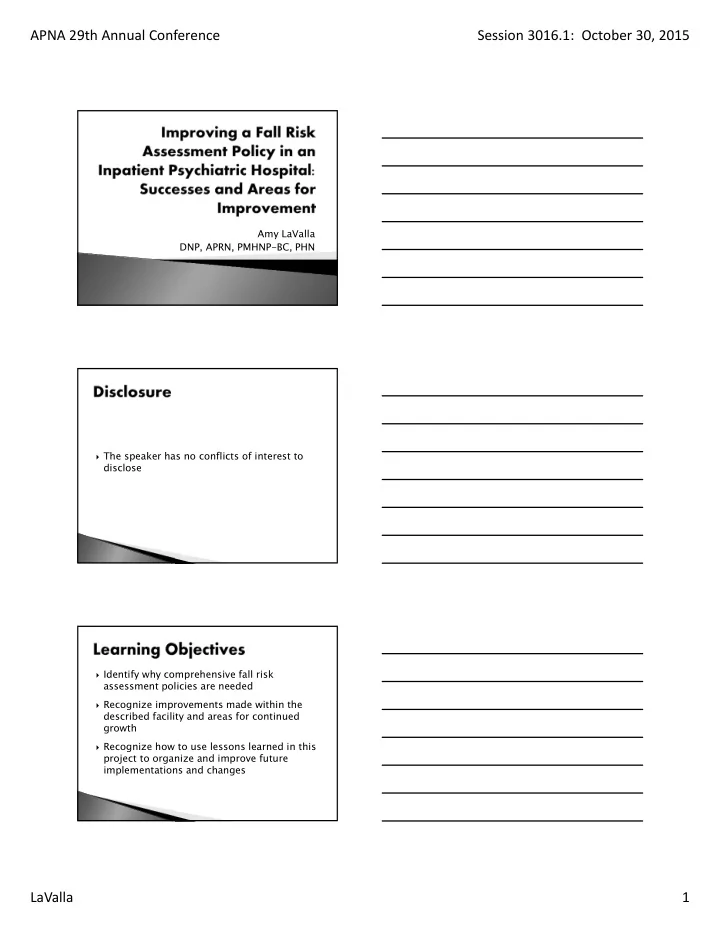

APNA 29th Annual Conference Session 3016.1: October 30, 2015 Amy LaValla DNP, APRN, PMHNP-BC, PHN The speaker has no conflicts of interest to disclose Identify why comprehensive fall risk assessment policies are needed Recognize improvements made within the described facility and areas for continued growth Recognize how to use lessons learned in this project to organize and improve future implementations and changes LaValla 1
APNA 29th Annual Conference Session 3016.1: October 30, 2015 Area of concern identified by The Joint Commission and Institute for Clinical Systems Improvement (Degelau et al., 2012) Falls can lead to: ◦ Injury (Healey et al., 2014; Lee, Geller & Strasser, 2013) ◦ Increased costs (Lee, Geller, & Strasser, 2013; Wu, Keeler, Rubenstein, Maglione, & Shekelle, 2010 ) ◦ Increased disability (Ivziku, Matarese, & Pedone, 2010; Oliver, Britton, Seed, Martin, & Hopper, 1997) Individuals in psychiatric hospitals have an increased risk of falling (Blair & Grunman, 2005; Edmonson, Robinson, & Huges, 2011 ) Additional fall risk assessment tools identified ◦ Suitability based on ages and medical conditions Updated policy included: ◦ Additional assessment tools ◦ Reassessment parameters Visual identification available for those found to be at risk for falling Fall risk reassessment rates ◦ 10% increase to 16.7% of patients reassessed Pat Patient ents R Reev evaluate aluated f d for r Fall R Risk B sk Befor ore an e and After ter Implementati Imp tion Before After 0.0% 5.0% 10.0% 15.0% 20.0% 25.0% LaValla 2
APNA 29th Annual Conference Session 3016.1: October 30, 2015 Visual identification after implementation ◦ 35.7% of patients correctly identified to be at risk ◦ 42.9% of patients incorrectly identified Use o e of Visual I sual Identif entification cation Proper Improper 0.0% 10.0% 20.0% 30.0% 40.0% 50.0% Finding appropriate tools Locating information in literature regarding policies or reassessment parameters Delay in implementation Accessibility of tools Improve staff training on new policy and tools Low accuracy of visual identification placed on/above doors Need to reinforce new policy via communication and leadership support ◦ Incorporation of change tactics (Packard, 2013) LaValla 3
APNA 29th Annual Conference Session 3016.1: October 30, 2015 Improvements made Project shortfalls may be utilized to improve future developments Communication is key! Blair & Grunman, 2005 Degelau et al., 2012 Edmonson, Robinson, & Huges, 2011 Healey et al., 2014 Ivziku, Matarese, & Pedone, 2010 Lee, Geller, & Strasser, 2013 Oliver, Britton, Seed, Martin, & Hopper, 1997 Packard, 2013 The Joint Commission, 2008 Wu, Keeler, Rubenstein, Maglione, & Shekelle, 2010 LaValla 4
Recommend
More recommend